| Article ID | Journal | Published Year | Pages | File Type |
|---|---|---|---|---|
| 8047062 | Applied Clay Science | 2014 | 8 Pages |
Abstract
Toluidine was polymerized with montmorillonite (Mt) by the chemical oxidation method using potassium perdisulfate by varying the toluidine to clay ratio. The solubility of the chemically prepared clay-polymer nanocomposites (CPN) was ascertained and it showed good solubility in DMSO and DMF. The in situ intercalative polymerization of o-toluidine (POT) within the Mt layers was analyzed by FTIR, UV-visible, XRD, SEM and TEM. The analyses of UV visible and FTIR spectroscopy demonstrated that o-toluidine has been polymerized to POT in its conducting emeraldine form. The conformation adopted by POT chains in the Mt interlayer depended on the molar ratio of o-toluidine to montmorillonite. FTIR spectra showed that amine vibration peak observed at 1593 cmâ 1 was shifted to lower wave numbers when the CPN were formed. SEM analysis showed the variation in morphology from granular agglomerate to layered flaky structure as the clay mineral concentration was increased. Elemental analysis was done by EDAX which shows the presence of Na, Mg Al, Si, C and N. Thermal stability of the CPN was studied using TGA/DTA and DSC studies. The X-ray diffraction studies revealed the formation of nano sized (28 nm) crystalline CPN. Cyclic voltammetric studies of the synthesized CPN exhibited good adherent behavior on electrode surface at pH 1.0. It exhibited one oxidation peak at 0.405 V and one reduction peak at 0.299 V. By varying the atmosphere it was found that the CPN modified electrode exhibited oxygen reducing capacity.
Keywords
Related Topics
Physical Sciences and Engineering
Earth and Planetary Sciences
Geochemistry and Petrology
Authors
R. Baby Suneetha, C. Vedhi,
